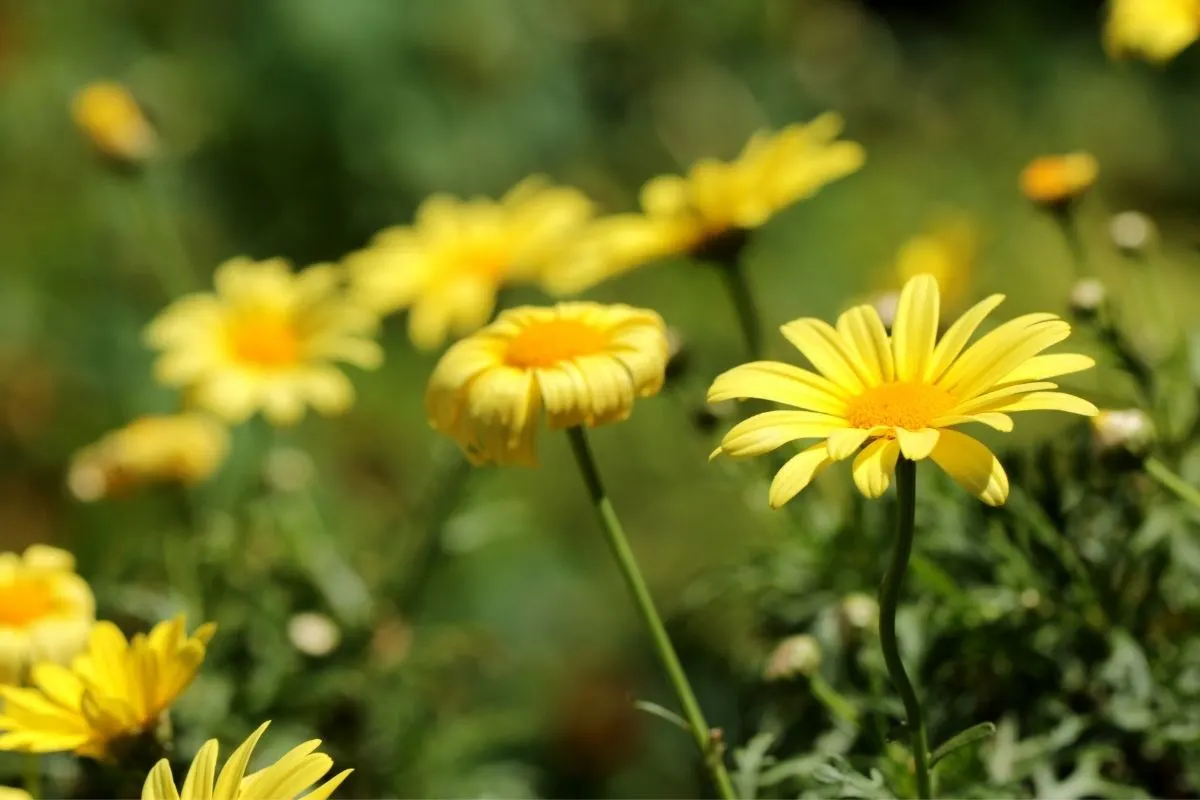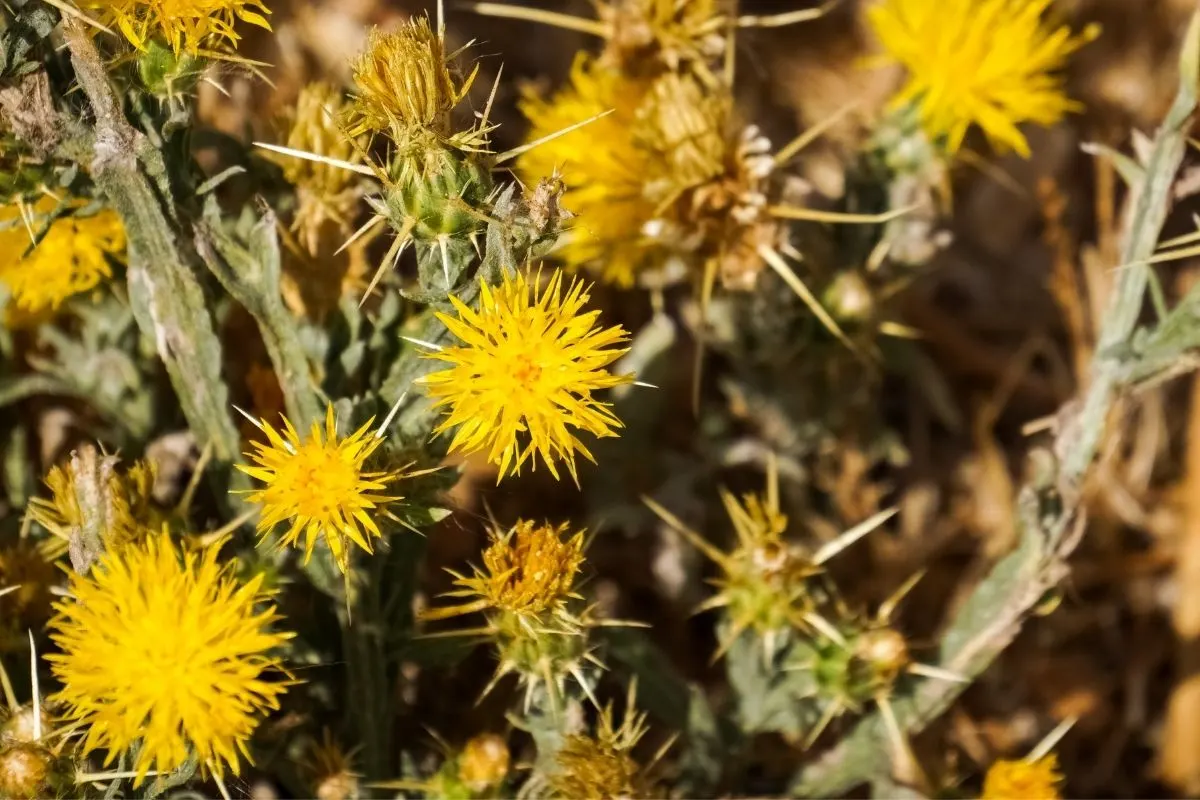Invasive species, from pathogens to mammals, can wreak havoc on local ecosystems. In the case of plants, invasives spread aggressively, out-competing native plants and thus reducing food and habitat for native wildlife. One or more of these noxious weeds might even be masquerading as innocent garden plants in your flower beds. Learn more about some of the worst invasive plants in Arizona so you can help reduce their spread and replace them with native plants to preserve and nurture important habitats.

Invasive Plants in Arizona
While there are many invasive plant species in Arizona, the following list contains some of the worst. Each description includes physical traits as well as effective control methods and similar native plants that can replace the noxious weed.
1. Buffelgrass (Pennisetum ciliare)

A warm-season, rhizomatous bunch grass, buffelgrass grows to three feet tall or more and equally as wide. Extremely drought tolerant, it readily spreads after fire, and its seeds disperse via animals, water, wind, and vehicles.
Its bristly flower heads grow one and a half to five inches long, with an equally broad range of color: yellowish, gray, or purple when fresh and golden when dry.
Because mechanical methods lead to an increased spread in the long term, targeted herbicide application is most effective in controlling buffelgrass.
Attractive native grass alternatives include bushy bluestem (Andropogon glomeratus) and blue grama (Bouteloua gracilis).
2. Camelthorn (Alhagi maurorum)

Camelthorn, an aggressive, creeping shrub has greenish-yellow spines on green stems and produces reddish, jointed seedpods. Its extensive roots penetrate deep into the soil and spread horizontally, allowing the plant to form dense colonies.
Mechanical control efforts have little effect. Instead, apply herbicide twice: at budding and after regrowth. Plant native shrubs instead, such as the red baneberry (Actaea rubra) or firecracker bush (Bouvardia ternifolia).
3. Diffuse knapweed (Centaurea diffusa)

Ranging from an annual to a short-lived perennial, diffuse knapweed has multiple branches and reaches one to three feet tall. Its yellow-green bracts have brown terminal spines and are topped by white to purple flowers. It grows in a wide variety of habitats throughout Arizona.
Controlled burning and herbicide application have proven to be the most effective against diffuse knapweed. Plant false boneset (Brickellia eupatorioides) or rush milkweed (Asclepias subulata) instead, both Arizona native plants.
4. Fountaingrass (Pennisetum setaceum)

A coarse, warm-season grass, fountaingrass grows in dense clumps that reach two to three and a half feet tall. It features reddish spike inflorescences about two to four inches long and prominent feathery flower heads. This escaped landscape plant can now be found along roadsides and in rangelands, and it reestablishes rapidly after burning.
Successive hand-pulling is effective on small patches, while herbicide works best on larger infestations. Plant native grasses instead, like alkali sacaton (Sporobolus airoides) or wood grass (Sorghastrum nutans).
5. Giant reed grass (Arundo donax)

A perennial, multibranched cane, giant reed grass forms clumps as wide as 20 feet with its creeping roots. The hollow, woody stems, covered in narrow, fibrous leaves, can reach six to 20 feet high. While plumed panicles top the canes, giant reed grass primarily spreads via rhizomes and stem fragments.
A combination of control methods work best, with hand-pulling for small patches and herbicides for larger being the single most effective. Choose native grasses, like bluejoint grass (Calamagrostis canadensis) or big bluestem (Andropogon gerardii) instead.
6. Musk thistle (Carduus nutans)

Musk thistle has a thick taproot and a rosette of hairless, spiny, deeply lobed leaves. Its nodding, powderpuff flowers reach up to three inches in diameter on stems as tall as eight feet and range from white to purple. A single plant can produce as many as 20,000 seeds (1/3 viable).
Thistles should be destroyed before they set seed. Herbicide use and late-season mowing are both effective management practices. Rocky mountain beeplant (Cleome serrulata) and purple prairie clover (Dalea purpurea) are two of many lovely purple native flowers.
7. Onionweed (Asphodelus fistulosus)

While the foliage of onionweed resembles that of onions, it does not smell or produce bulbs like onions. Rather, onionweed has dense fibrous roots. The six petals of the small, white to pink flowers each have a distinct brown midvein. This two- to three-foot plant occurs in urban areas and along roadsides.
Effective management techniques include mechanical methods repeated several times in a growing season and herbicide application. Similar native flowers include the sego lily (Calochortus nuttallii) and Pacific anemone (Anemone multifida).
8. Scotch thistle (Onopordum acanthium)

Ranging two to 12 feet high, Scotch thistle is an aggressive biennial with spiny, hairy leaves that have a grayish cast. Violet to reddish flowers reach two inches across and protrude from a bulb of spiny bracts. This imposing thistle has spread throughout the northern counties of Arizona.
Manual control is effective before the plant sets seed, and herbicides work as well. Plant a unique, native flowering plant instead, like tree cholla (Cylindropuntia imbricata) or cardinal catchfly (Silene laciniata).
9. Sweet resinbush (Euryops multifidus)

A low-growing shrub, sweet resinbush grows up to three feet tall and features narrow, deeply lobed, one-inch leaves that resemble needles. It typically loses its foliage in dry seasons, and from late winter to early spring, masses of small, yellow flowers cover the bush and give off a sweet but unpleasant odor.
The most effective management methods include mechanical removal and herbicide use. Rubber rabbitbrush (Ericameria nauseosa) and brittlebush (Encelia farinosa) are just two excellent native options for yellow flowering shrubs.
10. Tree of heaven (Ailanthus altissima)

Tree of heaven features large, compound leaves with lance-shaped leaflets. It produces terminal clusters of tiny, yellow-green flowers and twisted, winged, reddish-brown fruits. Both the flowers and wood, when scraped, give off an unpleasant odor. In addition to seed, tree of heaven spreads aggressively through root suckers.
It must be cut and the stump painted with herbicide. Always plant native trees, such as the lovely velvet mesquite (Prosopis velutina) or sweet acacia (Acacia farnesiana).
11. Yellow starthistle (Centaurea solstitialis)

Named for its ray-shaped yellow flowers, the yellow starthistle spreads aggressively via seed. It grows two to three feet tall and features linear stem leaves above a rosette of deeply lobed basal leaves. An extension of the leaves running down the stems gives a winged appearance.
Annual prescribed burns, grazing, and herbicide are all effective control methods, with a combination being the most effective. Two of the many beautiful yellow native flowers in Arizona include western goldentop (Euthamia occidentalis) and golden crownbeard (Verbesina encelioides).

With so many beautiful native plants in Arizona, it is easy to grow plants that support local ecosystems rather than enable the spread of destructive invasive species. The only problem might be choosing among the myriad options!











